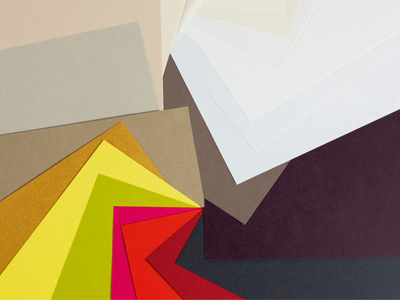From a small start, the coloured papers sector is on the march, driven in large part by expanding capabilities on modern digital presses.
You do not have to look very far to find the key driver behind growth in the coloured or tinted paper market: the increasing footprint in the market of digital printing systems that have white ink and clear ink capability. As designers become more educated about the possibilities and see what can be done in short runs, the demand can only grow.
It is an area that for the paper merchants is showing significant growth, albeit from a low starting point, leading John Vic, sales direct for Digital Media at Premier Paper Group, to state that demand has not reached a crescendo yet. People have been just printing the tint, but with continuous development of new colours to add to ranges such as Fedrignoi’s Sirio (available from Premier Paper), GF Smith’s Colorplan, and Antalis’ Keaykolour, and the trend towards added value print products bringing about greater use of white inks and metallic substrates, this is changing.
‘It’s a small area of the market but it is growing at quite a rate of knots, because of companies bringing white inks through for toner presses and for HP Indigo,’ said Mr Vic. ‘We want to bring more to market, and we are getting requests for 80 to 90 tints, but not in vast quantities.’
‘The more tinted material that becomes available on the market, the more likely it is that designers and brand managers will look to utilise such stocks,’ added Jim Whittington, digital specialist at Antalis.
‘Couple that with the advent of special effects in the printed process such as white and clear inks, textures etc. and you have the possibility to really make tinted material stand out from the crowd and make your printed piece work that much harder.’
Brands are looking to make their marketing material more effective, and this has led to much smaller print runs of more luxurious output. Tinted material helps tremendously with this goal in mind. It is also possible theoretically that a tinted paper may very closely match a brand’s corporate colour, which can remove a good deal of head scratching over colour management.
In vogue
The development of new colours is an interesting area. Sham Ahmed, national digital sales manager for Antalis, said that clients are looking for more modern, fashionable colours. Antalis, for example, changes the colours in its Popset range every 12 months, based on what is fashionable. There generally has to be a customer demand first however, John Vic pointed out.
‘We just extend the range with another tint as someone demands it or as we make it,’ he said. ‘Many of the colours are quite stark rather than pastel currently. I don’t think the demand is out there for that yet. If one big customer said they wanted pastel colours for digital applications, I could do it with that one company, and everyone else could get the scraps. But that big customer is not there yet.’
Reflecting the short run, high value nature of many of the applications that coloured papers are used for, many ranges are available in split packs. Antalis, for example, offers tinted papers from the Keaykolour and Popset ranges in quantities of as few as 25 sheets and any multiple of one above that. ‘This makes it far easier financially for brands to utilise these creative stocks and it has proved a tremendous success for the sales of these papers,’ said Jim Whittington.
How do these papers compare to standard papers in terms of quality? ‘The quality of all papers is much better today than it ever has been and this goes for the tinted materials on the market too,’ Mr Whittington continued. ‘Many creative paper mills now understand that whilst large run jobs are nice to pick up, they are few and far between, and it is much more likely that tinted materials will be used on short run jobs. This means supplying paper that will run on both liquid and dry toner technology in the precision trimmed size of SRA3+ or SRA3.’
It is still true to say ‘the smoother the better’ for digital printing, and many digital presses still struggle a little with heavily textured materials, he added, but this is a challenge that the mills and paper merchants are addressing and overcoming. ‘Materials like Keaykolour and Rives are running with tremendous success on a large swathe of the digital technology that is out there.’





